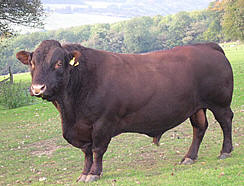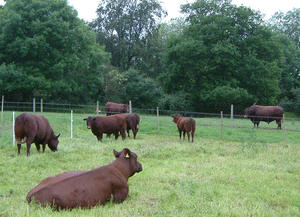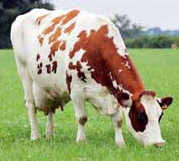



Sussex
History
Described at the Norman invasion of England in 1066, Sussex Cattle are indeed an ancient breed.It is said that the Sussex is descended from the horned “red cows” once found throughout much of southern England, inhabiting the dense forests of the Weald land of Sussex and Kent. In its original form one of its chief characteristics was its long, strong horns (– rather similar in style to those of the old English Longhorn).
They were used as draft animals for several years before being primed for beef production at the age of six or seven. They were bred for their speed in moving across territory, their hardiness when grazing on poor land and their muscling.
One of the earliest references to the purebred Sussex cattle was in 1793 by Arthur Young in his book 'Agriculture in Sussex'. In it he mentions that Sussex breeders' ideas ran strongly in favour of a dark red colour; and that the Sussex are remarkable for the fineness of their hides as they are for the closeness and delicacy of their flesh.
The breed was not seriously developed until the 1800's, when breeders began encouraging both the red colour and the beef qualities of these cattle.
In their heyday, Sussex cattle were noted for producing powerful, active bullocks suitable for working the heavy land of their native country. As the use of draught oxen gave way to horses, the Sussex became primarily a beef breed.
Over more recent decades, breeders of Sussex Cattle have evolved a carcase conformation aimed at producing a maximum of prime meat whilst retaining the inherent genetic qualities of the breed.
Characteristics
 Photo courtesy of Shabden Park Farm, www.shabdenparkfarm.com |
The Sussex cow measures approximately 135cm at the withers and weighs 585kg and the bull 145cm and 950kgs.
Sussex cows are thrifty, long-lived cattle well suited to today’s narrow market requirements and stringent economic climate. They are also fairly easy to handle because of their history as draft animals and can adapt well to most management systems.
The Sussex Breed ensures that its beneficial characteristics are easily fixed and passed on with great pre-potency in a crossbreeding program that will improve the foundation stock.
Statistics
- Quiet and easy to handle – have an excellent temperament and are well known for their placid nature.
- Mobility - Strong legs and good feet enable Sussex to walk long distances over difficult terrain (report from Zambia describes rustled cows covering 55km in 24 hours, finding their own way back home).
- High fertility - Sussex cows are easy calving, regular breeders well into their teens under commercial conditions.
- Easy calving – Sussex calves are small at birth having an average weight of 30-40 kg
- Early maturing - with a high percentage of saleable meat
- Efficient foragers - the Sussex maintain their condition even on poor quality feed. They are known for their non-selective grazing They have the Bos Indicus factor, will tolerate heat and drought Sussex bulls make ideal terminal bulls for dairy herds
- Heat tolerant – Pigmented skin and a high number of sweat glands (900+ per sq. cm.)enable the Sussx to thrive in many different conditions, they develop a smooth summer coat, plus in winter conditions, rapid growth of a winter coat ensures tolerance of cold enabling Sussex to be out-wintered on exposed marshes.
Comparative
Distribution
 Photo courtesy of Waverley Herd, Waverley Herd of Sussex Cattle |
They have also been exported to New Zealand in 1970 but there are only a few purebred herds as yet.
References (the above information was cited from the following sites)
studbook.co.za
sussexcattlesociety.org.uk
www.rarebreeds.co.nz
www.ansi.okstate.edu
Waverley Herd of Sussex Cattle


